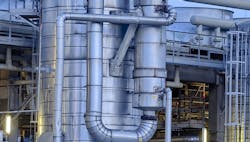Choose the Correct Thermosyphon Reboiler
An experienced colleague recently needed to design a horizontal thermosyphon reboiler. Until then, he had dealt exclusively with vertical thermosyphon reboilers. His latest assignment, though, required copying part of an existing plant that had a single horizontal thermosyphon reboiler amid lots of vertical ones.
“Why was that one service an exception?” he wondered. This spurred a broad discussion that covered a number of practical issues about thermosyphon reboiler design. These merit a wider audience, hence this column.
I asked my colleague if he knew the history of that reboiler. One reason one-of-a-kind equipment shows up in plants is that the item was a rush replacement or surplus equipment just sitting around. The concern here is whether this item, which differs from everything else, actually suits the future service. While copying lowers engineering costs and shortens the schedule, it’s counterproductive if the unit really wasn’t a good choice for the service.
Both horizontal and vertical exchangers will work fine as thermosyphon reboilers. The configuration of the exchanger and its piping will differ but there’s no fundamental reason why either can’t handle a specific service. So, why was one horizontal thermosyphon reboiler among all the vertical ones?
[pullquote]
Some plants, companies or industries strongly prefer one or the other based on previous experience. This historical bias influences future choices. If a plant already has 30 or more horizontal thermosyphon reboilers that work, it very likely will make the next thermosyphon reboiler a horizontal exchanger as well.
Bias aside, three technical issues can influence the choice between a horizontal and vertical thermosyphon reboiler:
• physical size and weight of the exchanger;
• maintenance and replacement requirements; and
• vacuum operation.
In general, economics favor the vertical design for smaller thermosyphon exchangers. The foundation and steel to put the exchanger up by the tower cost more but reduced piping for the tower-exchanger connections make the overall installation cheaper.
As the exchanger becomes larger and heavier, the difficulty and cost of removing the exchanger bundle for maintenance or repair increase. Large vertical exchangers require pulling the bundle up a long distance; so the extra expense incurred by a vertical exchanger climbs. Also, as the tower becomes bigger, the position of the exchanger rises with the greater size of the tower bottoms section.
Services and industries such as petroleum refining that have a history of large units with high maintenance requirements tend to choose horizontal exchangers because they provide lower maintenance costs and quicker maintenance work. Nearly all thermosyphon exchangers in petroleum refining are horizontal. The time and cost required, e.g., to pull a 30-ft-long, 5-ft-dia. exchanger vertically up 30 feet are prohibitive.
Conversely, for units with low maintenance requirements and small exchangers, vertical installation offers worthwhile savings. Thus, many smaller chemical plants have nothing but vertical thermosyphon reboilers.
Vacuum operation also can affect the choice. Vertical reboilers under vacuum tend to have a subcooled zone in the bottom that doesn’t do any boiling heat transfer. The static liquid head in the exchanger increases the pressure at the exchanger surface. The static head really won’t change the boiling temperature very much for systems under pressure. However, in systems under vacuum, this static head can significantly raise the boiling temperature above the temperature of the bottom stage in the tower. This reduces the heat transfer in the bottom section of the exchanger. Heat-sensitive systems under vacuum sometimes use horizontal reboilers to keep the reboiler temperature lower.
For exchanger thermal design, vertical thermosyphons have relatively few issues. The exchanger flow patterns are straightforward and velocities are high. The only significant flow problem is geysering, i.e., liquid accumulating in slugs if the velocity drops too low; avoiding this may require adding pressure drop to the exchanger inlet.
Horizontal thermosyphons often are much larger and have low vaporization-side (shell-side) velocities. This can lead to liquid recirculation in the exchanger and accumulation of heavy components. Good practice with large horizontal thermosyphons is to have two or more inlets to prevent horizontal flow gradients and reduce internal recirculation.
You can make both types of thermosyphons work. The biggest selection criteria are size and weight. Larger exchangers shift the choice toward the horizontal thermosyphon.

